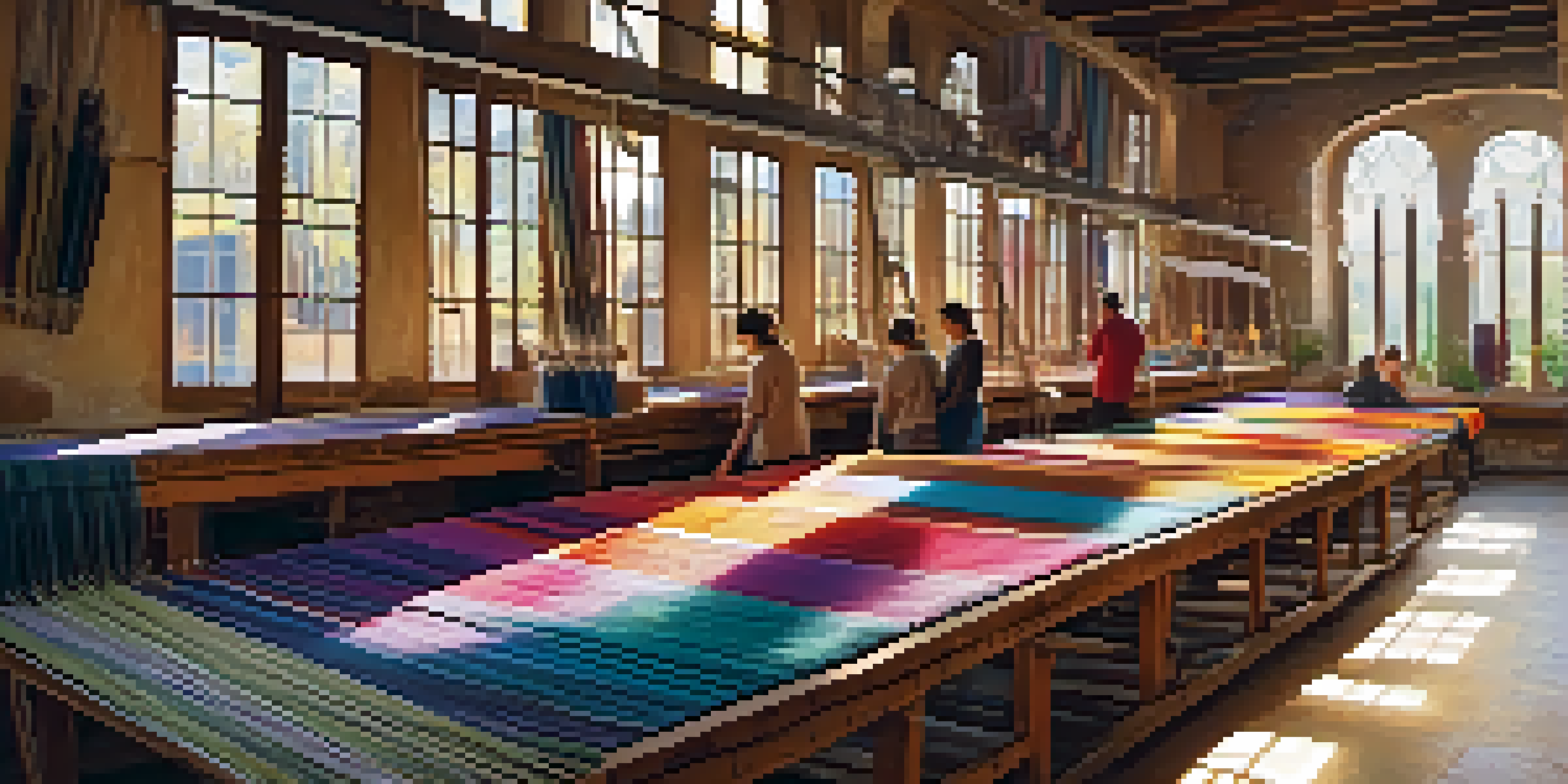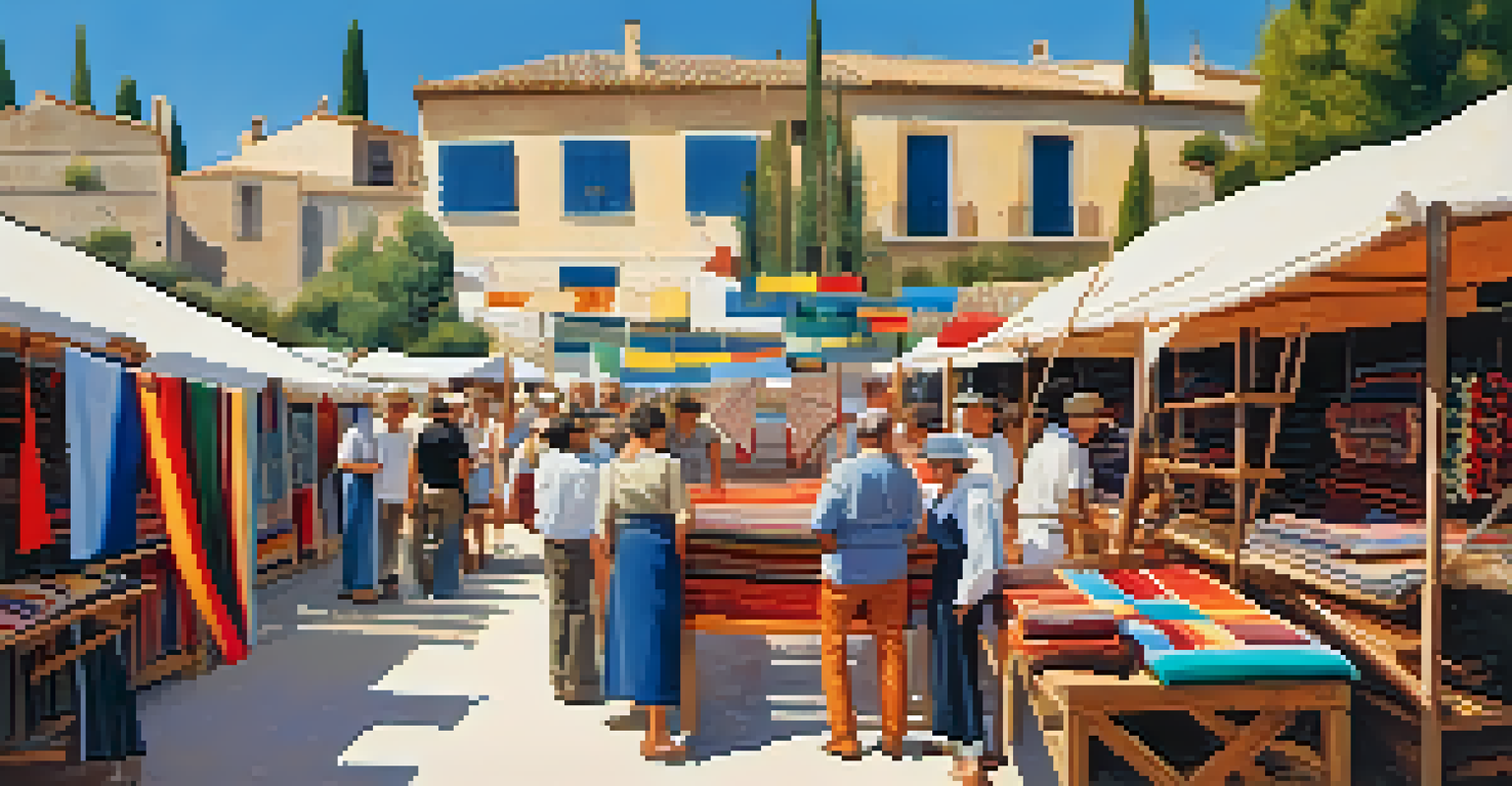Catalonia's Textile Traditions: Weaving Techniques Uncovered

A Brief History of Textile Weaving in Catalonia
Catalonia's textile traditions date back centuries, with roots in the medieval era. The region became a vital center for weaving, influenced by trade and cultural exchanges with neighboring areas. This rich history laid the foundation for unique techniques that have evolved over time.
Textiles are a reflection of the culture and history of a place; they tell the stories of the people who make them.
In the 18th century, Catalonia saw a boom in textile production, particularly for silk and cotton. Local artisans developed distinctive patterns and styles, making Catalan textiles sought after across Europe. These historical developments established a legacy that continues to inspire modern weavers.
Today, many artisans still draw from this heritage, blending traditional methods with contemporary designs. This fusion not only preserves the past but also showcases Catalonia's vibrant textile culture in a modern context.
Key Weaving Techniques of Catalonia
Catalonia is known for several unique weaving techniques, including 'sarga' and 'brocatel.' Sarga, or twill weaving, creates a diagonal rib pattern that adds texture and durability to the fabric. Brocatel, on the other hand, is a luxurious fabric often embellished with intricate designs, showcasing the skill of the weaver.

Another technique, 'tapiz,' involves creating tapestries that tell stories through woven imagery. These tapestries often feature bold colors and patterns, making them a focal point in any space. The artistry involved in tapiz weaving reflects the rich cultural narratives of the region.
Catalonia's Rich Weaving Heritage
Catalonia boasts a vibrant textile history that blends traditional techniques with modern innovations.
These techniques not only highlight the craftsmanship of Catalonia’s weavers but also their deep connection to the land and its history. Each piece created is a testament to the time-honored practices passed down through generations.
Materials Used in Traditional Weaving
The choice of materials plays a crucial role in Catalonia's textile traditions. Historically, local fibers like wool, cotton, and silk were favored for their availability and quality. Wool, known for its warmth, has been a staple in many traditional garments, while silk has been prized for its sheen and softness.
The past is not dead; it is living in us, and we are its faithful and creative heirs.
In recent years, there's been a resurgence in the use of natural dyes derived from plants and minerals. These dyes not only provide vibrant colors but also reflect the sustainable practices of local artisans. This eco-friendly approach resonates with modern consumers who value sustainability in fashion.
By utilizing locally sourced materials and traditional dyeing methods, Catalonia’s weavers honor their heritage while adapting to contemporary environmental concerns. This blend of old and new is what makes their textiles truly unique.
The Influence of Catalonia's Geography on Weaving
Catalonia's diverse geography has significantly influenced its textile traditions. From the coastal areas known for their fishing communities to the mountainous regions that support sheep farming, each location contributes unique materials and techniques. This geographical diversity enriches the weaving culture, offering a variety of textures and patterns.
The region's climate also plays a role, as the warm Mediterranean sun is ideal for drying and dyeing fabrics. This natural advantage has allowed artisans to experiment with colors, leading to the vibrant textiles that Catalonia is famous for today. The interplay between geography and textile production is a captivating aspect of the region's cultural identity.
Sustainable Practices in Textiles
Local artisans are increasingly using eco-friendly materials and methods, reflecting a commitment to sustainability.
Ultimately, the landscapes of Catalonia are not just backdrops but active participants in the weaving story. Each thread woven carries a piece of the land, connecting the weaver to their surroundings.
Catalonia's Modern Textile Innovations
While steeped in tradition, Catalonia's textile industry is not stagnant; it continuously evolves. Modern weavers are incorporating technology into their craft, using digital tools to design intricate patterns that were once painstakingly done by hand. This blend of traditional craftsmanship with modern innovation is opening new avenues for creativity.
Moreover, there's a growing movement towards ethical fashion within the region, with many artisans focusing on sustainable practices. By prioritizing fair trade and eco-friendly materials, these modern weavers are reshaping the industry while honoring their roots.
These innovations are making Catalonia a hub for forward-thinking textile design, attracting attention from fashion enthusiasts worldwide. As the industry adapts, it remains deeply connected to its historical foundations, ensuring that the essence of Catalonia’s weaving traditions lives on.
Prominent Textile Festivals in Catalonia
Catalonia hosts several vibrant textile festivals that celebrate its rich weaving heritage. One of the most notable is the 'Fira de Tardor' in the town of Igualada, which showcases local artisans and their creations. Visitors can explore a variety of stalls, attend workshops, and witness traditional weaving demonstrations.
Another key event is the 'Festival Internacional de Tèxtil' held in Barcelona, attracting textile enthusiasts from around the globe. This festival features exhibitions, talks, and networking opportunities, emphasizing both traditional techniques and modern innovations in the textile world.
Festivals Celebrate Textile Culture
Textile festivals in Catalonia, like 'Fira de Tardor' and 'Festival Internacional de Tèxtil', highlight local craftsmanship and community.
These festivals not only promote local craftsmanship but also foster a sense of community among weavers and consumers. They serve as a platform for celebrating the artistry and cultural significance of Catalonia's textiles, ensuring that these traditions continue to thrive.
The Future of Textile Weaving in Catalonia
As we look ahead, the future of textile weaving in Catalonia appears promising. The merging of traditional techniques with modern technology has opened up new possibilities for artisans. Younger generations are increasingly interested in preserving these skills, ensuring that the rich tapestry of Catalonia’s textile culture remains alive.
Furthermore, the global demand for sustainable and ethically produced textiles is propelling local artisans to innovate while staying true to their roots. This shift not only promotes environmental stewardship but also enhances the cultural footprint of Catalonia on the international stage.

Ultimately, the future of Catalonia's weaving traditions lies in striking a balance between honoring the past and embracing change. As long as artisans continue to weave their stories into every fabric, the legacy of Catalonia's textile traditions will endure.